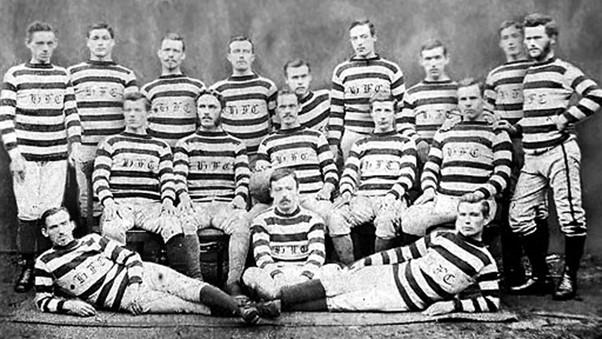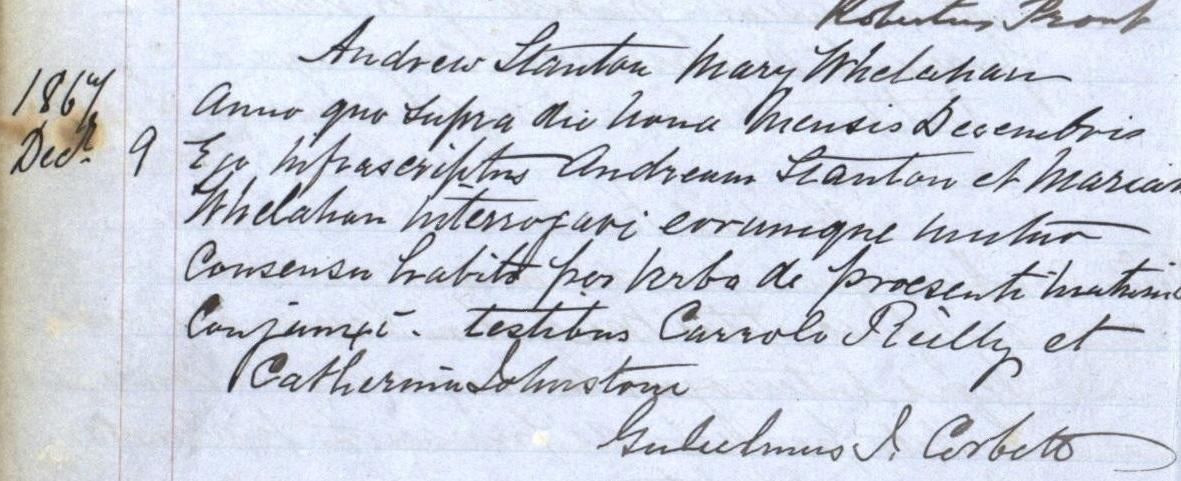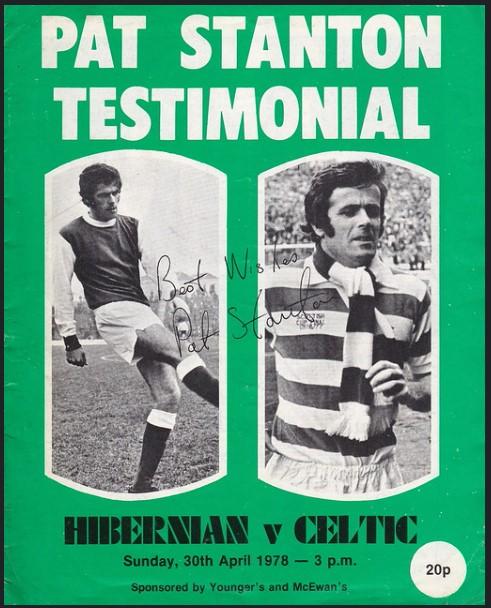Shared support for a football team is something than can often unite a family. However few families can boast having had as much impact on a single club as the Whelahan/Stanton family on Edinburgh’s Hibernian FC (Hibs). To mark the club’s 150th anniversary, Hibs unveiled the new Pat Stanton Stand (previously the East Stand) at their home ground at Easter Road. The stand is now named after their former captain and one of the club’s greatest servants. Pat Stanton made 399 appearances for Hibs between 1963 and 1976 and captained Scotland on three occasions. One of Hibs’ most revered players, Stanton’s connections to the club run deep; he is a relative of Hibs’ first ever captain, Michael Whelahan. We decided to trace this familial connection through the records available on Scotland’s People, creating Pat Stanton’s family tree.
On the evening of 6 August 1875 Canon Edward Joseph Hannan of St Patrick’s Church gave his permission for the St Patrick’s branch of the Catholic Young Men’s Society to assemble a football club. This team became known as Hibernian Football Club, the name deriving from the Classical Latin name for Ireland, Hibernia, meaning ‘land of winter.’ From these humble origins, Hibernian FC are today one of the best-known clubs in Scottish football, having won four league championships and three Scottish cups.
Genealogical research into the Whelahan family tree proved problematic as the family name was recorded in a variety of ways in the statutory registers, for example as Wheelahan, Whalican, Whelihan or Whelaghan. The family tree started to take shape by searching Scottish census records, which were the earliest records the family appeared in. The Whelahan family were found in the Old Town area of Edinburgh along with many other Irish emigrants in the Cowgate, known colloquially as ‘Little Ireland.’ Between 1800 and 1921 over eight million men, women and children emigrated from Ireland to Britain, North America and parts of the British Empire.

Crown copyright, National Records of Scotland (NRS), 1861 census, 685/04/30
Michael Whelahan was born in Ireland in 1854. He is first enumerated (with the family name being rendered as ‘Whalican’) in the 1861 census. As Michael’s place of birth is listed as Ireland, we can surmise that the Whelahans had moved to Scotland, sometime between 1854 and 1861. Michael is living at Conn’s Close near the Cowgate with his father Patrick, mother Bridget (née McDonald), older sister Mary and 8-day-old sister, Catherine. Cathrine died later the same year. In the 1871 census Michael was recorded as being aged 18. At the time of Hibernian’s foundation in 1875, Michael Whelahan would have been 21 years old.

Crown copyright, NRS, 1871 census, 685/4/28
By searching the census and statutory birth and death registers on Scotland’s People it is possible to place the Whelahan family in a historical timeline:
Father: Patrick Whelahan b. circa 1821, d. 1882
Mother: Bridget McDonald or Whelahan b. circa 1831, d. 1903
Daughter: Mary b. 1849, m. Andrew Stanton 1867, d. 1928
Son: Michael b. 1854, d. 1926
Son: John b. 1856, d. 1858
Son: John b. 1858, d. 1860
Daughter: Catherine b. 1861, d. 1861
Daughter: Elizabeth b. 1862, m. Michael Gilluley 1890, d. 1954
Michael Whelahan joined the St Patrick’s branch of the Catholic Young Men’s Society. Located in the Cowgate, it was started by Canon Edward Joseph Hannan (1836 – 1891). The Society was established to keep the Catholic youths occupied and divert them from unsavoury habits such as drinking and petty crime. Canon Hannan accepted the suggestion (possibly Whelahan’s) of starting a football team, a sport that was growing in popularity in Scotland. A well-regarded member of Edinburgh’s old town community, Canon Hannan was responsible for the largest Catholic congregation in the east of Scotland, a member of the City Parochial Board which was responsible for administering relief to the poor and from 1885 onwards, he was a member of the Edinburgh School Board.
Hibernian FC was established with Canon Hannan as its first manager and captained by Whelahan. The team of young Catholic men adopted the Irish harp as the team symbol and wore a green and white hooped jersey, similar in style to the modern-day Celtic kit. The team played their first game against rival Edinburgh side Heart of Midlothian FC on Christmas Day 1875. Both Hibs and Hearts played their early matches on the great expanses of grass in the Meadows, as did several other Edinburgh based clubs. The Meadows was originally a loch, drained in the 1740s to create parkland located south of the city centre.

Image credit: Hibernian F.C. website/Public domain
Alongside playing football, Michael found a position in the city’s growing printing industry and became a typefounder. He married Isabella Robertson in 1883. They had five daughters and four sons together.

Michael and Isabella’s second son was born in 1889. Named after his father, Michael followed in the footsteps of Canon Hannan by becoming the Very Reverend Canon Michael Whelahan. He was ordained at St Patrick’s in 1917, where he had served as altar boy. He died at Lourdes, the Catholic pilgrimage site in France, in 1949 (Edinburgh Evening News, 13 September 1949). Michael and Isabella’s youngest son, George Alexander Whelahan, born 1895 enlisted with the Connaught Rangers during World War One. George was killed during the first day of the German Spring Offensive, 21 March 1918. His service return on Scotland’s People states ‘presumed dead’ probably meaning his body was never found. George’s handwritten will in which he leaves his ‘property and effects’ to his father is also accessible on Scotland’s People:

Crown copyright, NRS, SC70/8/1231/2 page 3
Michael Whelahan’s eldest sister, Mary, married fellow Irish emigre Andrew Stanton (or Staunton) in 1867. In the 1861 census, aged 14, Andrew is living with his family in North Gray’s Close, off the Old Town’s High Street. He was employed as a dust carter, clearing house refuse from the local area.

NRS, MP 87 1 4 1406
Mary and Andrew Stanton initially lived in the familiar surroundings of the Cowgate and had six children. Their family members were:
Father: Andrew Stanton b. circa 1845, d. 1904
Mother: Mary Whelahan or Stanton b. 1849, d. 1928
Son: Michael b. 1869, d. 1946
Son: Edward b. 1871, d. 1939
Son: Patrick b. 1874, d. 1875
Daughter: Bridget b. 1878, d. 1968
Daughter: Margaret b. 1880, d. 1966
Daughter: Elizabeth b. 1882, d. 1961
Andrew and Mary’s son Edward Stanton, typefounder, married Catherine Madigan, paper bag maker, in 1894. Their marriage certificate states that they married at St Margaret’s Church on Easter Road. They both lived in the Cowgate at the time of their marriage and went on to have ten children. The family later moved to the Newington area of the city. Their son, another Michael, born 1906 was the future Hibs footballer Patrick (Pat) Stanton’s father. Michael married Bridget Dollan Gordon in 1936, and they lived in the Niddrie area, south of Edinburgh city centre.
Patrick Gordon Stanton was born at 01:20 am on 13 September 1944 in Peffer Bank, Craigmillar. Given his family connections, it was unsurprising that as a boy, Pat was an avid Hibs supporter and watched them play at Easter Road. Stanton showed promise as a player and joined youth teams including Salvesen Boys Club and Bonnyrigg Rose Athletic. He signed for Hibs in 1963. The following year he won the Summer Cup under then manager Jock Stein, who remained an admirer of Pat’s leadership skills and versatility on the pitch. Under manager Eddie Turnbull, Pat Stanton was part of a talented group of players at Hibernian, known as ‘Turnbull’s Tornadoes’ including Jimmy O’Rourke, Alex Cropley and John Brownlie. Like his Great-Great Uncle, Pat Stanton was appointed captain of Hibernian and led this exciting young team to a famous victory over Celtic in the 1972 League Cup final. The following season saw Hibs defeat Hearts by 7-0 in their traditional New Years’ Day fixture.
Able to operate in both midfield and defence, Stanton was blessed with excellent tackling, passing and positional sense, earning comparisons to England’s Bobby Moore. Between 1966 and 1974 Pat was selected to represent the national side on 16 occasions, three times as captain. Despite Stanton being in his thirties, his old manager Jock Stein, by then in charge at Celtic, signed him for a second time in 1976. Stanton’s leadership skills and defensive nous, saw him deployed as a deep-lying sweeper for the Glasgow club. Stanton had an almost instant impact on the club, as they won both the Scottish Cup and the Scottish league championship in the 1976-77 season, beating his old team Hibs in the final. Pat was forced to retire in 1978 due to a knee injury at the age of 33. Stanton pulled on the Hibs jersey one last time in April 1978 as he played in his own testimonial match between the two clubs he represented with such distinction. Played in front of thousands of fans at Hibernian’s Easter Road ground, it was a fitting end to a distinguished playing career.

Image credit: with permission from Miles McClagan via Flickr
This was not the end of Pat Stanton’s association with Hibs. After serving as Sir Alex Ferguson’s assistant at Aberdeen and managerial spells at Cowdenbeath and Dunfermline Athletic, he returned to the club as manager for a two-year spell between 1982-1984. He has continued to be involved with the club in various roles ever since. Pat Stanton is a member of both the Hibernian Hall of Fame and the Scottish Football Museum’s Hall of Fame. However, it is the stand at Easter Road that now bears his name that links Hibernian’s foundation with its present and future.
Sources used
- Irish Immigrants and Scottish Society in the Nineteenth and Twentieth Centuries. Ed. T M Devine (Edinburgh, 1991)
- Scottish Football Museum website